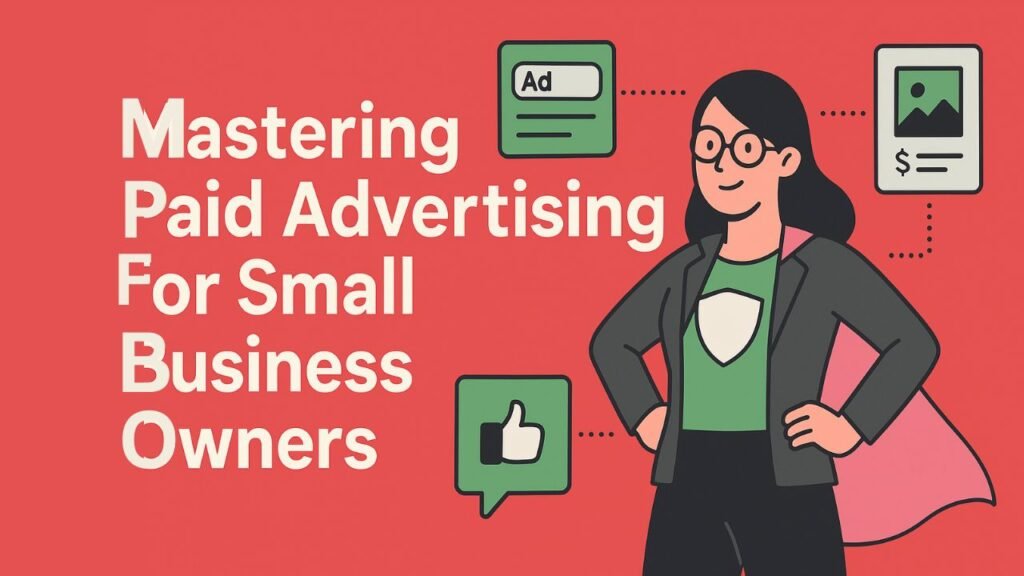If you’re running a small business, you’re wearing all the hats including owner, operator, marketer, customer support, and everything in between. Honestly, how are you not a superhero already?
Even with a team or outsourced support, you are the one responsible for steering the ship, especially when it comes to marketing strategies like paid advertising. And let’s face it: paid ads can feel like a whole other world. Complex platforms, budget decisions, confusing analytics, it’s a lot.
But the good news? Once you understand the basics, running paid ads becomes way less intimidating. Let’s break it down.
Why Paid Advertising Matters for Small Businesses
You might wonder: Do I really need to invest in paid ads when SEO and organic marketing are free?
The Value of Paid Ads in a Crowded Market
Organic content marketing and SEO are amazing, no doubt. They bring in traffic and build trust over time but here’s the catch: they’re competitive. Like, really competitive.
Big businesses with huge budgets have already staked their claim on the best keywords, and new content struggles to climb the ranks unless your domain already has authority. That’s where paid advertising can be a game-changer.
With paid ads, you get:
- Instant visibility on platforms like Google, Facebook, or Instagram.
- Highly targeted reach based on user behavior, interests, and demographics.
- Better conversion potential, since users clicking on ads are often already in a buying mindset.
In short: paid advertising helps you compete with the big players without needing to spend years building up your SEO strength.
Top Types of Paid Ads You Should Know About
Most paid advertising falls under the PPC (pay-per-click) model, where you only pay when someone clicks your ad. Here’s a quick rundown of the most popular types of paid ads you can use:
Search Engine Ads (Google Search Ads)
These ads appear at the top of Google search results and look just like regular search listings, except they have a small “Ad” label. They’re perfect for targeting keywords that your potential customers are already searching for.
Social Media Advertising
Platforms like Facebook, Instagram, Twitter, and LinkedIn let you create highly targeted ads based on user interests, location, age, and more. These appear as sponsored posts in user feeds and stories.
Display Advertising
Display ads are the banner ads you see on websites. These are great for brand awareness and can include images, animations, or even videos.
Google Shopping Ads for E-commerce
If you sell products online, Shopping Ads are a must. These appear as product listings in Google search results and include product photos, prices, and your store link.
Retargeting or Remarketing Ads
Ever visit a website and then see their ads everywhere afterward? That’s retargeting. These ads are shown to people who visited your site but didn’t convert giving you a second chance to make a sale.
How to Build a Budget-Friendly Paid Ads Strategy
Paid advertising doesn’t have to break the bank. If you plan it right, even a small budget can go a long way. Here’s how to make your dollars count:
Define Your Target Audience Clearly
Don’t try to target everyone. Focus on the people who are most likely to buy from you.
Use audience filters to narrow down your targeting:
- Age and gender
- Location
- Interests and behavior
- Devices they use
Also, build detailed buyer personas and use them when writing your ad copy. The more your message resonates, the higher your chances of converting clicks into customers.
Choose the Right Platforms
You don’t need to be on every channel. Choose platforms that align with where your audience actually spends time.
- Targeting Gen Z? Go for TikTok or Snapchat.
- Selling to Millennials? Focus on Instagram and Facebook.
- B2B? LinkedIn might be your best bet.
Surveys, polls, and customer feedback are great tools for understanding where your audience hangs out online.
Track Performance and Optimize
Don’t just set your ads and forget them. Monitor performance daily or weekly to see what’s working and what’s not.Keep an eye on metrics like:
- Click-through rate (CTR)
- Cost per click (CPC)
- Conversion rate
- Return on ad spend (ROAS)
If something’s not performing well, tweak your ad copy, images, or targeting. Testing and optimization are essential parts of every successful campaign.
Conclusion
If you’re only relying on SEO or organic content, you’re leaving a lot of potential on the table. On the flip side, if you rely only on paid ads, you might end up overspending for traffic that doesn’t stick.
The best strategy? Use paid advertising to accelerate growth, and organic marketing to build long-term trust. Together, they create a balanced and powerful marketing engine for your small business.
So go ahead and experiment, analyze, and tweak until you find your sweet spot. You might not be a superhero, but with the right tools and mindset, you’re definitely running your business like one.



